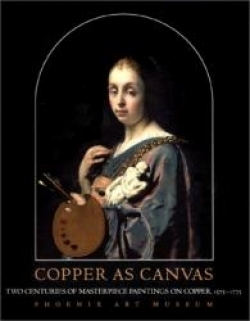
Copper As Canvas
Two Centuries of Masterpiece Painting on Copper 1575-1775
Falling from the arc light of artistic nomenclature, oil paintings wed to copper seemingly elude classification, withdrawing to a reclusive realm of art. After flourishing with ample time and fertile foreign soils to claim interest in employing hammered copper as a support, rather than traditional canvas, had declined in the late seventeenth century for both artist’s hand and patron’s eye. Lost in the shadow of an eclipsing art form, the prevalence of these brilliant paintings, despite their luminous artistry, would fade. Yet, the works, outwardly flushed with the latent abiding spirit of their earthly genesis, have become the gallery’s ore—without want for the warming light of recognition or need for the doled auxins of art history. Dancing freely between the light of popularity and coquettish turns with obscurity, these paintings endure with a sufferance inherent to the earth—where tunnels laden with precious ore echo the footfall of their marauders, as indifferently as gallery portals swallow their revolving traffic.
Following the solemn dedication to the memory of researcher Donald Rabiner is the incarnate of his vision, Copper As Canvas. This lushly voluminous account documents masterpiece paintings which copper supports boastfully projected between the mid sixteenth and eighteenth centuries across Europe and Spanish America. Abandoning its functional capacity as merely a catalog for a winter’s exhibition at the Phoenix Art Museum, the book evolves as a companion, calling upon a delicate art form that has become crushed with forgetfulness and nearly effaced with time.
The unveiling of the travelling 1998 exhibition in Phoenix introduced a pioneering collection, with many of its constituents never before having left their homelands. The exhibit garnered paintings from galleries and private collections of Europe and the Americas, in an effort to assemble a comprehensive homage to the twenty-ninth element of our earth and its irrepressible humanitarian value. Among various masters featured were Jan Breughel I, Bril, Rembrandt, Gellee, Wtewael and Gentileschi. With equal care and reverence paid to the element copper—its native forms and utilitarian value as first found in Neolithic hands and the art of mining—the exhibit, and subsequently the book, achieve an enduring and emotive awakening.
As a prelude to the anticipated catalog of oils, Copper As Canvas wisely orchestrates a procession of introductory writings submitted by an international team of scholars—essays that arm with historical and technical insight as they knowingly anoint with an elusive air of sanctity. These scholarly essays, which weigh half the book, provide an essential complement and reference for the following catalog, enlightening with the expertise and passion these changing voices lavish upon each topic. Benefiting immeasurably from the uniform intellectual level upheld by banding these experts, the book is carried without exposing a scholastic Achilles heel. In addition to presenting a short history of copper paintings, topics detail artists’ materials and techniques, as well as aspects of the copper industry, including mining, preparation and trade routes. The incorporation of maps, charts, photographs of relics and images not included with the exhibit (paintings not travel-worthy or otherwise inaccessible) collectively provide an effective ballast for the distant gravity of the exhibition catalog. All essays, though staunchly academic, are written with amorous verve, which in turn, seem to blushingly foster an unfolding canopy of expectant emotions.
By 1600, liturgical paintings, landscapes, mythological and allegorical imagery, naturalist, portraiture and miniatures of larger works were all genres drawn to the copper “canvas.” With most paintings able to fit the perimeters of a typist’s page, characteristic precision and often astonishing departures into minutiae court the onlooker, demanding an intimate gaze. The ability to engage these images privately and at arm’s length, as they once were, is reproduced here, dealing perhaps the book’s most powerful blow quite naturally. Following the initial introduction of the paintings’ metallic sheen to the literary-bound gallery-goer, is the nearly identical phraseology with each catalog entry passing. Authors consistently refer to the “jewel-like” character of these works, as well as the “extraordinary subtle transitions of light and atmosphere,” the chiaroscuro, which earmarks many pieces.
Without production shortcomings to betray the radiance of the images, or uneven writing to menace it, Copper As Canvas proves to be an aesthetically and intellectually gratifying work. Pages fall thickly with implied authority, its text swiftly spent in an unfaltering gait as opulent images rise. Comforting in the breadth of its research, few aspects of this brilliant art form go unacknowledged; its value beyond the appraiser’s grasp, the book finds an audience effortlessly, in lovers of art, of industry and of anything beautiful. These masterpieces emerge, as a spirit reconciled with form—once more shrugging the chill of its subterranean amnion and dressed in azurite robes.
Reviewed by
Karen Wyckoff
Disclosure: This article is not an endorsement, but a review. The publisher of this book provided free copies of the book to have their book reviewed by a professional reviewer. No fee was paid by the publisher for this review. Foreword Reviews only recommends books that we love. Foreword Magazine, Inc. is disclosing this in accordance with the Federal Trade Commission’s 16 CFR, Part 255.
